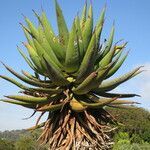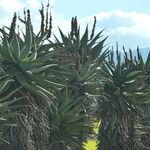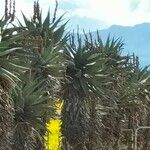Trees; stems simple, 2-4(-5) m tall. Leaves 50-60, arcuate-erect to spreading, 500-1000 x 65-150 mm, shallowly channelled, dull green to glaucous, sometimes reddish tinged, both surfaces with or without prickles. Inflorescence of cylindric or narrowly conical, very dense racemes, 5-12-branched, ±1 m tall; bracts ovate-acute, 7-11 x 3-6 mm, 3-many-nerved. Flowers scarlet to orange, very rarely yellow or white, 23-35 mm long; subclavate to ventricose; outer segments connate in lower third, inner segments free but dorsally adnate to outer in lower third; pedicels 3-8 mm long. Anthers exserted 9-25 mm. Ovary 5-7 x 2-4 mm, green; style exserted 12-25 mm. Fruit 20-23 x 10-12 mm, yellowish grey-brown. Seeds almost black, ±5.0 x 3.0 x 0.6 mm, broadly winged. Flowering time (May to) June to August (to November), depending on locality and minimum winter temperatures.
It can be a tall succulent plant. It can grow from 2-5 m tall. It normally has a single stem with the remains of the old dry leaves on it. The crown has the fleshy sword shaped leaves. These leaves are 15 cm wide at the base and taper to the tip. They are green but often tinged with red. They vary between being smooth to being very spiny. The edges have reddish teeth. Only one flower stalk develops. This can branch and have 5-8 erect closely packed flowering branches. These are normally bright red. The flowers are rich in nectar which is edible.
Succulent, perennial tree. Stem 2-3 m high, can be up to 5 m high, unbranched, erect, densely covered with persistent dried leaves. Leaves dull green, sometimes with reddish tinge, without spots, lanceolate-ensiform, up to 1 m long, surfaces smooth or with irregular scattered spines, margins with stout, deltoid, reddish to brownish red teeth. Inflorescence single, branched, erect, ± 1 m high, with cylindric, very dense racemes. Flowers orange, scarlet, yellow or white, ± 33 mm long; stamens and stigma well exserted. Flowering time May-Nov.
Succulent, perennial tree; caulescent. Stems 2-3 m long, simple, erect, densely covered with persistent dried leaves. Leaves with blade narrowly ovate-ensiform, up to 1 m long; margins with stout, deltoid, reddish to brownish red teeth, dull green, sometimes reddish tinged, without spots, with smooth or with irregular scattered spines. Flowers: inflorescence much branched, ± 1 m high, with cylindrical, very dense racemes; floral bracts 8-10 mm long; stamens and stigma well exserted; perianth ± 33 mm long, scarlet to orange; May-Nov.
Succulent, perennial tree. Stem 2-3 m high, can be up to 5 m high, unbranched, erect, densely covered with persistent dried leaves. Leaves dull green, sometimes with reddish tinge, without spots, lanceolate-ensiform, up to 1 m long, surfaces smooth or with irregular scattered spines; margin with stout, deltoid, reddish to brownish red teeth. Racemes cylindric, dense, branched, ± 1 m long. Flowers orange to scarlet, occasionally yellow or white, ± 33 mm long; stamens and stigma well exserted.



